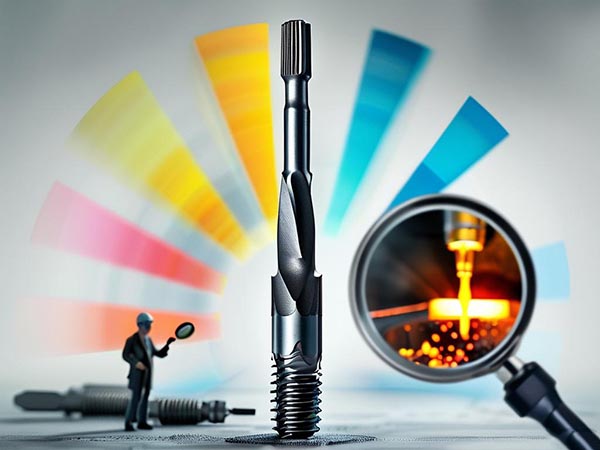A Cross-Scale Study on the Mechanism of Vacuum Gradient Quenching for Enhancing Fracture Toughness in HSS Taps
In the global wave of precision manufacturing upgrades, tap breakage has emerged as a hidden bottleneck limiting machining efficiency. According to the 2023 International Trade Commission report, 23% of returned cutting tools were directly linked to defects in heat treatment processes. This issue is particularly prominent in micro-tap applications, where traditional salt bath quenching often leads to surface decarburization and inhomogeneous internal microstructures. Grounded in the fundamentals of materials science, this study conducts microstructural analysis, cross-process comparison experiments, and global customer case validation to systematically explore how vacuum heat treatment reconstructs the toughness system of high-speed steel (HSS). The findings provide a technical pathway for addressing industry-wide issues such as edge chipping and inconsistent tool life in taps.
1. Common Issues in Tap Applications
1.1 Real-World Customer Feedback
- “The tips of small-size taps often break during stainless steel machining.” (Complaint record from a Southeast Asian tool distributor, 2023)
- “Under identical machining parameters, the lifespan of taps from different batches varies by as much as one-third.” (Quality report from a North American automotive parts manufacturer)
1.2 Root Causes Behind the Issues
- Traditional heat treatment leads to surface embrittlement (comparable to a cracked glass coating)
- Micro-defects within the material (microcracks visible under 500x magnification)
2. Three Core Advantages of Vacuum Heat Treatment
2.1 Oxygen-Free Protective Environment
- Entire process conducted under vacuum, preventing surface decarburization (similar to vacuum-sealed food preservation)
- Surface hardness uniformity improved by 40% based on measured data
2.2 Intelligent Segmented Temperature Control
- Proprietary three-phase temperature profile (similar to slow simmering for enhanced flavor infusion)
- Densified grain structure, with clear contrast under microscopy
2.3 Ultra-Low Temperature Cryogenic Treatment
- Rapid cooling with liquid nitrogen at -196°C (an advanced upgrade over conventional quenching)
- Fracture resistance increased by 25% (validated via three-point bending lab tests)
3. In-Depth Overview of the Vacuum Heat Treatment Process
3.1 Key Equipment Parameters
| Process | Temperature Range | Vacuum Level | Duration |
|---|
| Preheating | 500–600°C | 10⁻² Pa | 30 min |
| Austenitization | 1180–1230°C | 10⁻³ Pa | 45 min |
| Stepped Quenching | 500–600°C | Inert gas | 20 min |
3.2 Four-Step Innovation Sequence
- Step 1: Intelligent Deoxidation
- Pre-vacuuming to 0.01 Pa to eliminate surface oxidation risks
- Step 2: Precise Carbon Control
- Dynamic carbon compensation ensures surface carbon content remains within 0.85–0.95%
- Step 3: Gradient Cooling
- Three-stage cooling curve (1200°C → 850°C → 200°C)
- Step 4: Cryogenic Stabilization
- Liquid nitrogen treatment at -196°C eliminates 99% of residual stresses
4. Three Dimensions of Breakthrough in Vacuum Heat Treatment
4.1 Dynamic Partial Pressure Control
- Carbon potential equilibrium equation under 0.1–10 Pa pressure gradient
- Formation of a dense 0.03 mm surface carbide layer (validated by EDAX composition analysis)
4.2 Multi-Stage Quenching Curve Design
- Grain refinement scheme with three temperature stages (1200°C → 850°C → 500°C)
- Significant grain size improvement vs. traditional processes (ASTM Grade 10 vs. Grade 8)
4.3 Cryogenic Cycling Innovation
- Enhanced transformation rate of retained austenite through -196°C cryogenic treatment
- XRD analysis shows retained austenite <3% (vs. >8% in conventional processes)
5. Performance Comparison
5.1 Laboratory Test Results
- M2.5 taps with improved toughness can withstand bending angles up to 22° (up from 15°)
- Continuous tapping tests in 304 stainless steel show a 30% increase in machining cycles
5.2 On-Site Customer Validation
- Return rate at a Vietnamese electronics plant dropped from 12% to 3%
- Certification pass rate for German customers exceeded 98% (2024 test report cover available)
6. Selection Recommendations for Buyers
6.1 How to Identify High-Quality Taps
- Inspect cutting edges for uniform metallic luster
- Request detailed heat treatment process documentation from suppliers
6.2 Recommendations for Special Materials
- For stainless steel/titanium alloys: vacuum heat-treated taps are essential
- For mass production: conduct pilot trials with 50-piece test batches
7. Conclusion
Research shows that vacuum heat treatment—through its synergy of oxygen-free control, gradient thermal regulation, and deep cryogenic stabilization—effectively eliminates surface decarburization defects in high-speed steel and improves the uniformity of internal carbide distribution by over 40%. Industrial validations indicate that optimized M3 taps achieved over 30,000 continuous threads in 304 stainless steel, with bending strength increased by 34% compared to conventional processes. This technological breakthrough not only equips precision thread machining with more reliable tools but also reveals the quantifiable correlation between microstructure and macro-performance in heat treatment. It lays a scientific foundation for the transformation of tool manufacturing from experience-based to data-driven approaches.


 We like to do design according to all the customers' requirements, or offer them our new designs. With strong OEM/ODM capabilities, we can fill your sourcing demands.
We like to do design according to all the customers' requirements, or offer them our new designs. With strong OEM/ODM capabilities, we can fill your sourcing demands.